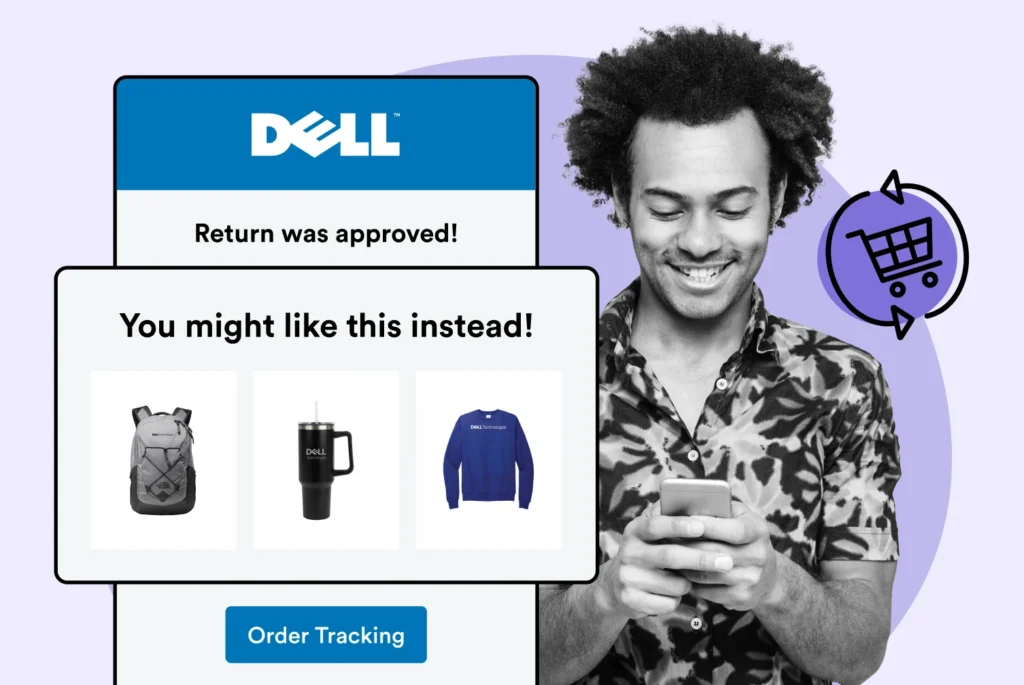
Maximize Refunds for an Enhanced Return Experience
Are returns hurting your customer loyalty? Actually, an enhanced return experience with refunds can actually reinforce customer satisfaction!
Boost customer experience and reduce support tickets
Realtime order and shipment tracking
Proactive order and shipping notifications
Predictive pre-purchase estimated delivery dates
Self-Serivce branded order tracking
Effortless experience delivered
Make returns profitable and delight customers
Flexibility to define any return destinations & conditions
Simplify returns for your customers and team
Incentivize exchanges over returns
Returns management made easy for your team
Understand why your customers are returning
Unify the online and the in-store experience
Hassle-free pickup experience for customers
In-Store Dashboard to keep operations streamlined
In-Store and Online orders unified
Drive foot-traffic to your stores
Boost customer experience and reduce support tickets
Realtime order and shipment tracking
Proactive order and shipping notifications
Predictive pre-purchase estimated delivery dates
Self-Serivce branded order tracking
Effortless experience delivered
Make returns profitable and delight customers
Flexibility to define any return destinations & conditions
Simplify returns for your customers and team
Incentivize exchanges over returns
Returns management made easy for your team
Understand why your customers are returning
Unify the online and the in-store experience
Hassle-free pickup experience for customers
In-Store Dashboard to keep operations streamlined
In-Store and Online orders unified
Drive foot-traffic to your stores
Find the answer to all your questions
Explore the most comon questions about WeSupply
Calculate the ROI that WeSupply can bring you
Request a no strings attached review of your current shopping experience and missed conversion opportunities
Take a step by step trip through our functionality to see how we can improve your ecommerce processes.
Read actionable articles on how to optimize your post-purchase experience and decrease support tickets
Get inspired by stories of how our customers implemented an effortless post-purchase experience
A Deep Dive into Top Companies' Order Tracking & Returns Strategy
Wondering if WeSupply is a good fit for you? Read through our use cases to see how we can help you increase conversion & improve CX!

The hidden costs of refunds go far beyond the returned purchase price in e-commerce. In the lifecycle of a product return, your business incurs additional, often-overlooked financial strains that can reduce your profit margins and disrupt operations. This article offers a concise exploration of these hidden costs and their impact on your store’s performance, providing the Why behind the What as it guides you through minimizing these unexpected expenses.
Refunds in eCommerce encompass more than the repayment of the purchase price; they include multiple costs such as customer acquisition, shipping, labor, lost revenue and environmental impact, potentially affecting a company’s bottom line.
A strategic approach to managing and reducing refund and return costs is crucial, including encouraging exchanges over refunds, enhancing customer experience, streamlining return policies and processes, leveraging customer feedback, and optimizing reverse logistics.
The environmental footprint of returns is considerable, with extensive CO2 emissions and landfill waste, requiring businesses to consider sustainability and the adoption of eco-friendly return logistics to mitigate their impact.
WeSupply streamlines eCommerce returns with automation, analytics, and customer-focused features. It reduces refunds by automating returns, encouraging exchanges over returns, and offering sustainable “Green Returns.” The platform enhances customer engagement with flexible policies, printerless QR returns, and proactive notifications, all while leveraging analytics to improve operations and satisfaction. Optimize your returns and boost satisfaction. Get started with WeSupply today!
The decision of a customer to return an online purchase extends beyond merely refunding the purchase price. There’s a whole lot more at stake. The costs associated with returns, exchanges, and customer service are just the tip of the iceberg. Beneath the surface, there’s an entangled web of hidden costs that can significantly impact your bottom line.
What, then, distinguishes returns, refunds, and exchanges? While these terms are often used interchangeably, they each have distinct implications for an online retailer.
A return involves the customer sending the product back
An exchange means swapping the product for another
A refund is the repayment of the purchase price
Each of these options carries its own costs and implications for your online business, and the exact opportunity cost depends on your specific situation.
Customer refunds involve more than just financial implications. They are deeply intertwined with the psychological aspects of customer satisfaction and loyalty. Often, a product return signifies unmet customer expectations. This disappointment can leave a lasting impression and potentially signal the end of their relationship with your brand.
A refund might solve an immediate problem for the customer, but it can also be a sign that the customer’s loyalty to your brand is fading. If not handled correctly, refunds can lead to a loss of customer trust and even future business, making it crucial for online retailers to navigate the refund process effectively.
WeSupply’s Returns Analytics feature plays a crucial role in understanding the impact of refunds on customer relationships by offering insights into the reasons behind product returns. By identifying the most returned products and understanding why they are returned, businesses can pinpoint areas for improvement in their product lineup or customer service. Additionally, recognizing patterns among serial returners can help companies develop targeted strategies to address these customers’ needs. This detailed analysis enables a deeper comprehension of customer behavior, fostering stronger, more informed relationships that can lead to enhanced satisfaction and loyalty.
Understanding the financial impact of refunds necessitates an exploration of the various costs they entail. These costs include:
Customer acquisition
Shipping
Labor
Lost revenue
Environmental impact
Each of these elements plays a role in the overall cost of handling refunds and returns.
Frequently, a customer’s request for a refund denotes a termination of their relationship with your brand, impacting their lifetime value. This means that the money you spent on acquiring that customer, which averages around $45 for eCommerce brands, goes down the drain. It’s like paying for a ticket to a show, only to walk out halfway through. And it doesn’t stop there. You’re now faced with the added costs of re-acquiring customers who were lost due to returns, as customer acquisition involves tangible expenses such as advertising and promotional offers.
Customer Acquisition Cost (CAC) encompasses the total expenses involved in acquiring a new customer, including production, storage, and delivery expenses. While reducing CAC presents a significant challenge for eCommerce businesses, successful optimization or diversification of marketing channels can provide substantial opportunities. Managing the financial performance of your online business requires careful monitoring of CAC, given its influence on product pricing and control of marketing costs.
A comprehensive understanding of CAC is necessary for setting product prices, as it informs businesses about the costs related to expanding their customer base.
For eCommerce businesses offering free returns, shipping costs and return costs pose a substantial financial burden. Your business absorbs these costs, adding a financial burden that could be around $7 for each refund. Ineffective reverse logistics, the process of handling returns, repairs, and exchanges, can result in increased operational costs such as higher transportation and inventory holding expenses.
However, efficient reverse logistics can enhance profitability and customer experience through streamlined processes and new technologies. Encouraging customers to opt for exchanges instead of refunds can help retain revenue and continue customer relationships. Furthermore, investing in return-ready packaging that can be easily reused can reduce costs associated with reverse logistics.
By analyzing return data, businesses can identify the root causes of returns, allowing for adjustments that can lower return rates and associated costs.
WeSupply offers a comprehensive solution to mitigate the financial burden associated with return logistics through its automated returns management system and insightful analytics. By automating the returns process, WeSupply significantly reduces the time and effort required to manage returns, minimizes returns fraud, and reduces human errors. It also allows for the collection of images and feedback to better understand customer concerns. Furthermore, by incentivizing exchanges over returns, WeSupply helps maintain sales and potentially increase the average order value. The platform’s detailed returns analytics provide valuable insights into the most returned products and the reasons behind these returns, enabling businesses to identify trends and implement strategies to reduce the return rate effectively.
Key Features:
Incentivize exchanges over returns: Maintain and potentially increase sales through instant store credit.
Returns Analytics: Identify trends and reasons behind returns, and strategize to reduce the return rate with actionable insights.
Leveraging WeSupply’s comprehensive returns management and strategic customer engagement solutions can significantly elevate your Return on Investment (ROI) by decreasing operational expenses, enhancing customer loyalty, and fostering repeat business. To discover the specific financial benefits WeSupply can offer your business, use our ROI Calculator.
Incentivize exchanges over returns
Book a quick call with our experts to see how WeSupply can help you save sales through exchanges and boost the average order value using instant store credit.
The processing of returns demands considerable labor, spanning from return management to possible product repair or repackaging. This labor can amount to significant labor costs, estimated at $15 per hour, assuming 2 hours spent per return. The returns process also includes expenses due to transportation and inspection, even when items are returned in good condition.
How you handle returns can play a crucial role in customer satisfaction and retention. Negative experiences with returns can lead to customer loss, damaging loyalty, and future revenue opportunities. Therefore, effective customer service responses, including handling customer service calls, to the common reasons for returns can help businesses reduce their number of returns.
Refunds represent not merely a lost sale, but frequently, a lost customer. This includes the loss of all the resources invested in that customer, such as marketing efforts and customer service time. Moreover, the opportunity cost of a refund can be significant, considering that a 5% increase in customer retention can lead to a 95% increase in profitability.
Acquiring a new customer can be up to 7 times more costly than retaining an existing one, which increases the exact opportunity cost of refunds. If the refund process is part of a poor customer service experience, there is a high chance of losing future revenue from the customer, as many customers will end their customer relationship with a company over bad service.
While less frequently discussed, the environmental impact of returns is an aspect of refund costs of equal significance. Processing returns involves using resources for shipping and potentially disposing of products, contributing to environmental concerns. E-commerce returns contribute to significant environmental degradation, with up to 9.5 billion pounds of returned items ending up in landfills annually.
The return of online purchases leads to around 24 million metric tons of CO2 emissions worldwide each year, equivalent to the emissions from over 5 million cars. Businesses can mitigate the environmental impact of returns by offering incentives for customers who keep their purchases, ensuring returned items are resold, donated, or recycled rather than landfilled.
WeSupply tackles sustainability concerns in returns logistics with innovative features designed to reduce waste and environmental impact. Its “Green Returns” policy allows refunds without needing items to be shipped back, cutting down on landfill waste. Automated and printerless return options, including QR codes, streamline the process and minimize paper use. In-store or curbside returns save on shipping and speed up inventory management. Lastly, WeSupply’s intelligent dispositions ensure returned products are sent to recycling centers or suitable alternatives, further lessening the environmental footprint.
Key Features:
Generate Return Labels Automatically: Simplifies the return process, reducing the need for manual intervention.
Printerless Returns via QR Code: Minimizes paper waste by eliminating the need for printed return labels.
Return In-Store or via Curbside: Reduces shipping-related carbon emissions and promotes faster inventory turnaround.
Intelligent Dispositions: Routes returns to recycling centers or suitable channels, significantly cutting down on waste and environmental impact.
Ready to revolutionize your returns process and boost sustainability? Book your demo with WeSupply today and take the first step towards a greener, more efficient future!
A multifaceted strategy, taking into account all elements of the refund process, is required to tackle the costs of refunds and returns. From encouraging exchanges over refunds to leveraging customer feedback, every strategy plays a crucial role in minimizing the financial losses and maintaining customer engagement.
By offering bonus credit, customers may be incentivized to opt for exchanges or store credit over a refund, thereby preserving sales and customer loyalty. Prioritizing exchanges and store credit as the first options when initiating a return can help steer customers away from refunds. Providing extended return windows and free shipping for exchanges and store credit may further encourage customers to opt for these alternatives to refunds.
Using return automation workflows in the returns portal can streamline the process of exchanges and store credit for both customers and merchants. This makes the process less time-consuming for customers and less resource-intensive for businesses, leading to a win-win situation.
WeSupply boosts customer engagement and minimizes financial losses by encouraging store credit and exchanges. Offering instant store credit for exchanges helps retain sales and increase order values. Refunding via store credit or gift cards cultivates customer loyalty and repeat business. Extending exchange periods beyond standard return windows adds flexibility, fostering long-term loyalty. Additionally, free return shipping on exchanges incentivizes customers to choose exchanges over refunds, enhancing satisfaction and loyalty.
Key Features:
Refund to Store Credit, Gift Card, or Coupon Code: Encourages repeat shopping and builds trust.
Offer Free Returns on Exchanges: Incentivizes exchanges, increases loyalty, and improves the shopping experience.
To minimize errors in orders and reduce returns due to incorrect items being shipped, eCommerce businesses are encouraged to automate their shipping process with software that processes orders efficiently. A clearly articulated return policy that instructs customers on the steps to return a product, including time frames, contact points, and costs involved, can also help to streamline the returns process.
Companies should educate their employees about the return policy to ensure that they can competently assist customers with returns and maintain customer satisfaction. Including a return label with orders is a contemporary trend in e-commerce that simplifies the return process for customers. Providing alternatives, such as store credit for items that cannot be returned, can help maintain good customer relations and reduce the number of returns.
WeSupply simplifies the returns process with technology and flexible policies, enhancing customer satisfaction and loyalty. Its branded returns portal offers a seamless, omnichannel experience, while the self-service option saves businesses time. Flexible return rules adapt to various scenarios, streamlining policy management. QR code labels make returns easy without printing, and integrated tracking provides transparency. Proactive email and SMS notifications keep customers informed, encouraging repeat business.
Key Features:
Branded Returns Portal: Enhances customer loyalty with a seamless experience.
Self-Service Returns: Saves time and meets customer expectations for a frictionless process.
Flexible Returns Rules: Adapts to different use cases, simplifying policy management.
QR Code Return Labels: Facilitates easy returns without the need for printing.
Integrated Returns Tracking: Offers customers transparency and easy tracking.
Proactive Post-Purchase Notifications: Engages customers with updates and personalized offers.
Returns, prevalent in the apparel industry due to size discrepancies or change of mind, can be reduced by enhancing the customer experience. Here are some strategies to consider:
Use high-quality visuals in online shopping to showcase product details and provide a consistent photographic style. This can reduce product returns related to appearance discrepancies.
Provide updated and accurate product descriptions to give shoppers a clear understanding of what they are purchasing.
Highlight detailed customer reviews to help shoppers make informed purchasing decisions. By implementing these strategies, you can help prevent returns and improve customer satisfaction.
Implementing strict quality control measures and utilizing inventory management software can minimize errors in order fulfillment and consequently reduce returns. Some strategies to reduce returns include:
Implementing strict quality control measures
Utilizing inventory management software
Providing accurate product descriptions and images
Offering virtual try-on or augmented reality tools to help customers visualize products
Providing detailed size charts and measurements
Offering clear return policies and instructions
By implementing these strategies, you can minimize returns and improve customer satisfaction.
Online reviews influence buying decisions for over 93% of customers, implying that encouraging and rewarding customer reviews can both increase sales and reduce returns. Recording and analyzing each return with its reason can lead to insights on improvements needed to reduce future returns.
One way to decrease return rates and increase net revenue is by utilizing customer feedback, particularly addressing negative reviews to improve products and customer experience. Reviews confirming basic product features, like fit and color, can enhance a brand’s credibility and reduce product returns by helping customers make more informed decisions.
Businesses can identify and resolve recurring issues highlighted in customer reviews by cross-referencing these with returns analytics, thereby reducing returns and promoting customer loyalty. Customer service teams play a crucial role in this process.
WeSupply harnesses customer feedback and returns data to foster product and process improvements, aiming to minimize return rates. Through Returns and Logistics Analytics, it helps identify high-return products, understand return reasons, and gather customer insights, enabling targeted actions to enhance satisfaction and reduce financial impacts. Additionally, tracking Customer Satisfaction (CSAT) and Net Promoter Score (NPS) guides continuous refinement of the customer experience. This strategic approach not only streamlines operations but also boosts profit margins.
Key Features:
Logistics Analytics: Supports a data-driven decision-making process to enhance customer satisfaction and loyalty through constant fine-tuning and adaptation based on CSAT and NPS scores.
Ready to transform insights into action and reduce returns? Book a demo with WeSupply now and start optimizing your post-purchase experience today!
The implementation of reverse logistics solutions can significantly reduce both the costs and environmental impact of returns. Here are some ways to improve reverse logistics:
Improve packaging for shipped products to reduce returns due to damage
Better pinpoint courier-related issues to minimize returns
Implement efficient reverse logistics processes to recover value from returned items
By implementing these strategies, you can improve your eCommerce fulfillment and contribute to better supply chain management.
Proper management of reverse logistics costs can lead to the utilization of fewer raw resources for remanufacturing, thus decreasing production expenses. By reducing the environmental impact of disposing returned products, reverse logistics can help create a more sustainable business practice. Transparent and efficient handling of returned merchandise through reverse logistics can improve customer satisfaction and potentially lead to repeat business.
To better illustrate the concepts discussed in this blog post, let’s delve into some real-world examples and detailed scenarios. Businesses such as Amazon and Zappos have successfully reduced refunds and enhanced customer loyalty by implementing efficient return policies, offering excellent customer service, leveraging customer feedback, and optimizing their reverse logistics.
Just like in the case of Evereve, when the pandemic-induced online shopping surge led to a dramatic increase in returns, Evereve faced unsustainable return rates and operational challenges. Recognizing high returns as more than just a necessary evil, Evereve, with the help of WeSupply, reimagined their returns process. By automating returns through WeSupply’s integrations and focusing on proactivity, self-service, and return flexibility, Evereve transformed returns into opportunities. This strategic shift not only streamlined their operations but also enhanced customer loyalty, reduced support tickets, and improved overall efficiency, turning a challenge into a competitive advantage. Discover how Evereve transformed challenges into opportunities with WeSupply. Read the full case study.
As the world of eCommerce continues to evolve, so too must the approach towards refunds and returns. Balancing profitability with customer satisfaction and environmental sustainability is the future of eCommerce. By understanding the hidden costs of refunds, online retailers can implement effective strategies to reduce these costs, enhance customer loyalty, and ultimately improve their bottom line.
The focus extends beyond merely reducing refunds; it encompasses a complete reevaluation of customer service, logistics, and sustainability in eCommerce.
This blog post has taken you on a journey through the hidden costs of refunds in eCommerce, from customer acquisition and logistics to environmental impact. We’ve seen how these costs can significantly affect an online retailer’s profitability and looked at strategies to reduce these costs while enhancing customer loyalty. The future of eCommerce lies in a holistic approach that balances profitability with customer satisfaction and environmental sustainability. As we move forward, it’s essential to keep these points in mind and continue to innovate and adapt in the ever-evolving world of eCommerce.
WeSupply stands at the forefront of reducing refunds and uncovering hidden costs in eCommerce stores by offering a multifaceted approach. Its automated returns management system and insightful analytics streamline the returns process, save significant time and effort, and provide actionable insights to reduce return rates effectively. By incentivizing exchanges over returns and offering options like “Green Returns” and printerless returns, WeSupply not only maintains sales but also addresses sustainability concerns. The platform boosts customer engagement through instant store credit, flexible return policies, and proactive post-purchase notifications. Furthermore, leveraging customer feedback and returns data, WeSupply enables continuous product and process improvements, ultimately enhancing customer satisfaction and boosting profit margins. Transform your returns process and unlock hidden savings. Get Started with WeSupply today and see the difference!
Combat inconvenience with proactivity & self service
Book a quick call with our experts to see how WeSupply can help you make returns easy for your customers with a beautiful, self-service solution that makes their experience easier while also providing new ways to lower costs and earn back revenue.
Refunds in accounting are treated by crediting the cash account for the amount of the refund if the customer has already paid, or by crediting accounts receivable if the customer has yet to pay, resulting in a reduction of assets on the balance sheet.
The hidden costs of refunds in eCommerce can include customer acquisition, shipping and return expenses, labor and customer service, lost revenue, opportunity costs, and environmental impact. Be mindful of these potential expenses when managing refunds.
To reduce refunds and return costs, online retailers can encourage store credit and exchanges, streamline the returns process, enhance customer experience, and leverage customer feedback. By implementing these strategies, online retailers can effectively minimize refund and return expenses. Additionally, identifying common reasons for refunds and implementing reverse logistics solutions can also help reduce costs associated with returns. These measures not only save money for the retailer but also improve customer satisfaction and loyalty.
WeSupply incentivizes exchanges over returns and offers instant store credit, encouraging customers to opt for exchanges and maintain their engagement with the store, thereby minimizing financial losses.
WeSupply leverages customer feedback and returns data to identify high-return products and understand return reasons, enabling targeted actions to enhance satisfaction and reduce financial impacts.
Yes, WeSupply does have an official Shopify App. You can download and begin to integrate it with your Shopify store.
Yes, WeSupply has an official extension for Magento. The WeSupply x Magento integration allows for automating order tracking experiences, reducing customer inquiries, automating shipping email and SMS notifications, and providing a fully branded order tracking experience
Yes, WeSupply has an official BigCommerce App. You can integrate WeSupply with your BigCommerce store to improve your post-purchase customer experience.
Learn How To Create Successful Post Purchase Email Campaigns
Build an effective post-purchase email flow that helps you increase customer satisfaction and drive revenue growth!
WeSupply is transforming the way businesses build Customer Lifetime Value by offering positive exchange experiences. By making exchanges effortless, WeSupply encourages customers to revisit your website for any product, without price constraints. Key features like using store credits or gift cards as partial payments not only increase order values but also reinforce customer loyalty. This approach is instrumental in enhancing Customer Lifetime Value, as it turns a simple exchange into a delightful shopping experience, fostering long-term customer relationships and ongoing business growth.

Are returns hurting your customer loyalty? Actually, an enhanced return experience with refunds can actually reinforce customer satisfaction!

Dive in to uncover how well-handled returns can drive repeat purchases and become a powerful catalyst for repeat business!
Cutting to the heart of direct-to-consumer success: DTC brand metrics that will navigate your strategic decisions and drive business growth!

Metrics to track, why they’re significant, and how they can guide your strategies toward minimizing returns and enhancing customer loyalty!

Let’s unpack effective strategies to influence return behavior that balance customer needs with business viability!

Let’s discover the indispensable benefits of such a dashboard, delving into the must-have features, vital metrics, and seamless integrations!

What are returnless refunds? Get ready to navigate the pros and cons of this revolutionary approach to returns!

Let’s discover the golden rules for financial savvy: optimizing cash flow, cutting needless costs, and strategic planning!

This article provides actionable insights for businesses ready to embark on a sustainable packaging journey!